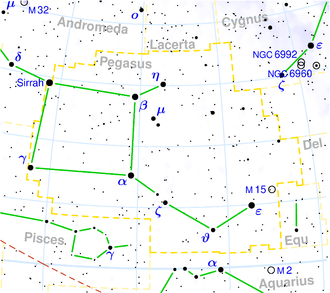NGC 7638
| Galaxie NGC 7638 / IC 1483 | |
|---|---|
![KUG 2320+110B & NGC 7638[1]](http://upload.wikimedia.org/wikipedia/commons/thumb/8/80/NGC7638_-_SDSS_DR14.jpg/300px-NGC7638_-_SDSS_DR14.jpg) | |
| KUG 2320+110B & NGC 7638[1] | |
| AladinLite | |
| Sternbild | Pegasus |
| Position Äquinoktium: J2000.0, Epoche: J2000.0 | |
| Rektaszension | 23h 22m 33,1s[2] |
| Deklination | +11° 19′ 44″ [2] |
| Erscheinungsbild | |
| Morphologischer Typ | S [3] |
| Helligkeit (visuell) | 14,9 mag [3] |
| Helligkeit (B-Band) | 15,7 mag [3] |
| Winkelausdehnung | 0,6' × 0,6' [3] |
| Flächenhelligkeit | 13,6 mag/arcmin² [3] |
| Physikalische Daten | |
| Rotverschiebung | 0.026592 ± 0.000050 [2] |
| Radialgeschwindigkeit | 7972 ± 15 km/s [2] |
| Hubbledistanz vrad / H0 | (363 ± 25) · 106 Lj (111,3 ± 7,8) Mpc [2] |
| Geschichte | |
| Entdeckung | Andrew A. Common |
| Entdeckungsdatum | 8. August 1880 |
| Katalogbezeichnungen | |
| NGC 7638 • IC 1483 • PGC 71242 • CGCG 431-046 • MCG +02-59-030 • IRAS 23200+1103 • KUG KUG 2320+110A • | |
NGC 7638 = IC 1483 ist eine Spiralgalaxie vom Hubble-Typ S im Sternbild Pegasus am Nordsternhimmel. Sie ist schätzungsweise 363 Millionen Lichtjahre von der Milchstraße entfernt und hat einen Durchmesser von etwa 65.000 Lichtjahren.
Im selben Himmelsareal befinden sich u. a. die Galaxien NGC 7627, NGC 7630, NGC 7639, IC 1484.
Das Objekt wurde am 8. August 1880 von Andrew Ainslie Common entdeckt.[4]
Weblinks
Einzelnachweise
Auf dieser Seite verwendete Medien
Autor/Urheber: Sloan Digital Sky Survey, Lizenz: CC BY 4.0
The sky image is obtained by Sloan Digital Sky Survey, DR14 with SciServer.
Angle of view: 4' × 4' (0.3" per pixel), north is up.
Details on the image processing pipeline: https://www.sdss.org/dr14/imaging/jpg-images-on-skyserver/



